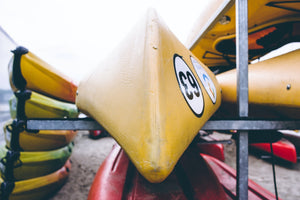How to Choose a Kayak – A Buyer's Guide
Jan 24, 2022
These days, the kayak market is huge– and it’s constantly expanding. There’s a kayak for just about every paddling purpose you can think of. Picking from such a gargantuan range is not an easy thing to do… Especially if you’re new to the sport. Here at Bay Sports, we know it can sometimes feel like you’re paddling in circles.
Today’s article is here to steady your course. What follows is an in-depth buying guide. First, we run through some basics of kayak design (think hull shape; length and width) and construction (think hard shells and inflatables; material choices and technology). Following this, we touch on a few of the established types of kayaks out there, and detail what each one is great for, and not so great for.

Before we get into it, there are a few questions you should ask yourself:
- What style of kayaking do you enjoy?
- What type of water do you like to paddle in?
- What mode of transport do you have access to?
Keep your answers to these questions in mind. Considering these will help you to avoid buying the wrong kayak.
A Kayak for Every Setting
It would be much easier if there was a single, universal kayak for every situation and style. However, this is not the case. The sheer variety of kayaking destinations (open ocean, raging rivers, calm lakes…) and objectives (cruising, fishing, racing…) warrants an equal variety in the kayaks that are produced for them. Your first step as a buyer should therefore be to match the variety of kayak to the type of paddling you want to do.

What makes a kayak fit for one style of paddling, and unfit for another?
This comes down to differences in kayak design, most notably in:

1. Hull Type
There are four main hull types in kayak design, and each are suited to certain paddling styles and purposes. In order of most stable to least stable, they are:
a) Flat hulls:
Perfect for beginners and calm bodies of water. They are the most stable of the four hull types, but they also offer the least water resistance, meaning that they won’t track as well in strong currents or waves.
b) Pontoon hulls:
Pontoon hulls are also incredibly stable. Rather than presenting as flat, they concave down the centre of the hull, effectively splitting the hull into two (like a catamaran). Pontoon hulls are great for activities which require good stability but also decent handling, such as fishing.
c) Round hulls:
Round hulls are the pick for both speed and manoeuvrability. They are, however, less stable than flatter hulls and are therefore better suited to intermediate and advanced paddlers. This hull type is great for rougher conditions that require rapid changes in direction and speed.
d) V-shaped hulls:
V-shaped hulls are the fastest and most aggressive hull type of the bunch. The sharper hull cuts into the water, giving these kayaks the best tracking ability. The main drawbacks of a V-shaped hull are that it can be harder to manoeuvre and less stable than more subtle designs. This hull type is best suited to long distance and fast paddling.
2. Length and Width
The length and width of a kayak plays a large role in determining what it is or isn’t suited for. Generally speaking, shorter kayaks with more width will usually be more manoeuvrable, and oftentimes more stable. However, these kayaks will not track as well, nor be anywhere near as fast as longer, narrower kayaks. In turn, longer, narrower kayaks will usually be less manoeuvrable and less stable than shorter, wider kayaks. To simplify:
Short and wide = slower, more stable, more manoeuvrable
Long and narrow = faster, less stable, less manoeuvrable
This distinction is a very simplified one, however, it is a good rule of thumb to keep in mind if you're new to the sport.
3. Weight capacity
The weight capacity of a kayak indicates how buoyant a kayak is, and how much it will be able to carry without having its performance severely affected, or, in the worst of scenarios, sinking. Kayaks with a heavier weight capacity are suited to carrying multiple paddlers, lots of gear (i.e., for fishing or touring), or heavier paddlers, and will usually be more stable, but also slower through the water. Kayaks with a lower weight capacity will often be faster and more manoeuvrable but are in turn only suited to a single paddler and little to no gear (i.e., for Whitewater kayaking).
4. “Sit on top” and “Sit in” Kayaks
Sit on top kayaks are kayaks that you quite literally sit on top of, rather than within. They generally run flatter and wider than sit in kayaks and are better suited to beginners due to the solidity and stability this flatter design offers. Sit on tops are best suited to calmer water and less intensive kayaking expeditions, but with a few customisations (such as upgraded seats or a backrest) they remain a solid choice for longer days on the water. Sit on top kayaks furthermore feature scupper holes (small holes in the deck that let water drain out– not in) that make them an incredibly user-friendly style of kayak. In sum, sit on top kayaks are perfect for leisurely, recreational paddling in warmer conditions– the perfect choice for a kayaking trip where you’re keen to jump in and out of the water as you please!

Sit in kayaks, on the other hand, have a cockpit that encloses the paddlers legs and waist, thereby keeping their weight and the hull of the kayak lower in the water. Sit in kayaks are generally faster, but also less stable than sit on top kayaks. They are generally better suited to longer expeditions, as their cockpit minimises exposure to the elements, while also harbouring dry storage space for gear. Sit in kayaks are the perfect choice for journeys like the Murray River Paddle and the Pittwater Paddle, or any longer medium to long distance river trip you can think of. For these trips, or any paddling in harsh conditions or cold water, sit in kayaks give you the option to attach a spray skirt that stops water from entering the cockpit to keep you warm, dry, and protected throughout your paddle.

Now that you know some basic design principles, let’s have a look at a few of the main varieties of kayaks!
Types of Kayak
Recreational Kayaks:
Recreational Kayaks are superb all-rounders. Perfect for that person who wants to go explore different types of environments, these are mainly sit-on-top kayaks, designed to seat 1-2 people. Extremely popular for families and part time enthusiasts, they feature changeable seating positions to cope with a person of any size, as well multiple length footrests. Not too technical and very easy to use… perfect for that Sunday afternoon paddle around the bay!

Touring Kayaks:
A common mistake made is to assume that a Touring Kayak and a Sea Kayak are the same thing. If you are keen to pack your camping gear and go exploring, then a Touring Kayak is the one for you! Touring kayaks have a hollow hull which provides the storage space needed for these expeditions. Touring Kayaks come on both tandem and single formats, and focus mostly on comfort, efficiency, and stability to maximise time out on the water.

Sea Kayaks:
Are you looking for a kayak to take on open waters, with speed? Sea kayaks are sit-in kayaks that run narrower than recreational kayaks to focus more on speed and glide. You’ll often find they come ready to be outfitted with extras like a feet-guided rudder, or outriggers to help tackle rougher waters. Many sea kayak owners are keen on spray skirts to keep them a little drier when the conditions are subpar.

Fishing Kayaks:
You can think of the fishing kayak as the fishing-obsessed sibling of the recreational kayak. These kayaks are dialled in for angling, with extra width in the hull to create a stable, reliable fishing platform. It’s not unusual to see customised fishing kayaks. Many anglers enjoy modifying their kayak to match their style of fishing. Accessories like rod holders and devices such electronic fish finders are often mounted to fishing kayaks. Another big plus of fishing kayaks is the storage space, designed to keep not just the fish you catch but also bait, spare lines and snacks and drinks for the day. The seating design can differ depending on the type of fishing you intend on doing, so keep that in mind… it's well worth considering an upgraded seat such as the Stadium Kayak Seat for ultimate comfort and enjoyment for hours fishing on the water.

Inflatable Kayaks:
The last few years have seen some serious improvements in the Inflatable Kayaks on the market. Perfect for those who don't have the storage space, these kayaks can be deflated and packed away to fit in your hall cupboard, or even the car boot. They are lightweight, making them easy to carry. Many inflatable kayaks come in a backpack style bag, perfect for that weekend away if you don’t have much space in the car, or plan on using public transport to get to your next adventure..

Racing Kayaks:
Racing Kayaks are made for one purpose… speed. Made from lightweight materials like fiberglass and carbon fibre, racing kayaks are built to go as fast as humanly possible in a straight line on calm, flat water. If you are considering getting into more competitive kayaking and want to race, this is the kayak for you. Long, narrow and built for speed!
What Next?
Now you know some of the different types of kayaks available... But how do you decide which is the right one for you? The first step is to reconsider those first three questions we posed, in light of the new knowledge you now have on kayak design, and the affordances that different designs offer. The most important thing is to centre yourself in the decision-making process. You don’t want to change your paddling style or objectives to suit the kayak you buy. The kayak you buy should fit you, and what you want to use it for.
If you figure out exactly what you want from a kayak, the right one will be easy to find.
Another great resource is our kayak selector. Check it out here to get your search underway!

Finally, don’t forget that after you find your perfect kayak, you’ll need a few extras. Two essentials you’ll need are a Paddle and a Life Jacket. Check out the Bay Sports accessories page here for a great range of paddles and life jackets!

